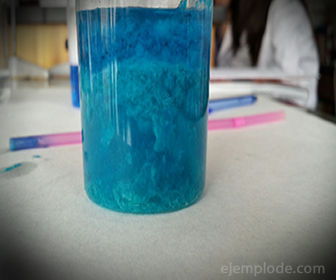Gravimetric Analysis Example
Chemistry / / July 04, 2021
A Gravimetric Analysis is a type of Chemical Analysis that focuses on discovering how much is there of a certain substance of interest in a worked sample, through the measured weight after a procedure or laboratory run.
To the substance to be measured or calculated by means of a weighing, it is called Analyte. In Gravimetric Analysis, the amount of Analyte must be separated from the other components of the mixture or sample, as well as the solvent that has been involved in the separation mechanism.
Separation Methods in Gravimetry
The separation methods are mainly of two types: Precipitation Methods and Volatilization Methods. Other methods are Electroplating, Solvent Extraction and Chromatography.
In the Precipitation Methods, the Analyte is converted into a sparingly soluble Precipitate that after a treatment that leaves it pure and stable, it is weighed. It is the most frequently used and with depth of concepts.

In the Volatilization Methods, the Analyte or its decomposition products they volatilize at a suitable temperature.
The gas produced with this volatilization is collected and weighed or else the analyte mass is determined indirectly by difference, such as the loss of mass in the sample.Gravimetric Analysis by Precipitation
The Precipitation Gravimetric Analysis Method generally consists of seven well-defined stages:
1.- pH adjustment
2.- Adding the Precipitating Reagent
3.- Digestion
4.- Filtration
5.- Washing
6.- Drying, and in certain cases, Calcination
7.- Weighing of the Pure Precipitate
A requirement that is essential to take into account for this method to be effective is that the Precipitating Reagent reacts specifically or selectively with the Analyte.

The Final Precipitate must meet the following characteristics:
a.- Be easily filterable
b.- Be very slightly soluble, so that it is not distributed inside the solvent. Practically insoluble.
c.- The Precipitate must not react with the components of the atmosphere, because it would alter every second before the final weighing.
d.- It must have a known composition or formula after drying or calcining.
e.- It must precipitate quantitatively, that is, in such a way that it can be calculated or measured.
f.- Enjoy High Purity.
Formation and Properties of Precipitates
The diameter of the ions is a few tenths of an Angstrom (1 Angstrom = 10-8cm); when they join, they form crystals, which must grow to a diameter greater than 10-4cm so they can precipitate.
During the Growth Stage, the particles go through a colloidal stage (diameter less than 10-4 cm), in which they can still pass through a filter, and are not useful for determining a weight. Already when they exceed this diameter and are more solid and stable, they are able to stay in a filter and begin to give confidence to the analysis.
The Nucleation and Growth are the two processes that can be distinguished to reach the formation of a precipitate. The average particle size of a precipitate is determined by the prevailing process.
The largest particles are achieved when Growth predominates.

Types of Precipitates
The Precipitates, according to the size of their particles, can be of 3 types: Colloidal Suspensions, Crystalline Precipitates, or Coagulated Precipitates.
The Colloidal Suspensions are those that are commonly obtained. Colloidal particles pass through all kinds of filters. Fortunately, by heating, stirring or adding an electrolyte it is possible to make them bind to each other forming agglomerates with amorphous mass, not a crystal, which sediments and can be filtered.
The process of converting a colloidal suspension into a filterable solid is known as coagulation or flocculation.
The peptization is the process in which a coagulated colloid returns to its original state. To avoid this, an electrolyte is added to the wash water.
The Crystalline Precipitates, what are the most desirable precipitates but there are very few that can be obtained, they filter more easily than coagulated colloids. Unfortunately, very few substances form crystals when they precipitate. The size of this type of particle can be improved by using dilute solutions, slowly adding the precipitating reagent, and shaking the solution well.
The Digestion of a Precipitate helps a lot in the growth of crystals. It consists of keeping the precipitate in contact with the solution, without stirring, at a temperature of around 80 ° C.
The Coagulated precipitates They are obtained by making the Particles agglutinate.
To obtain better Precipitates, it is recommended to slowly add the Precipitating Reagent, which must be diluted, stirring and in hot solution, in addition, approximately one hour.
Contamination of Precipitates
Precipitates can be contaminated by two processes: Co-precipitation and Post-precipitation.
The Co-precipitation It is the process in which a substance that is normally soluble is carried along with the precipitate. It can occur due to Occlusion or Adsorption of the impurity. In Occlusion, an impurity is enclosed within the crystal, due to the fact that it grew around it. In adsorption, the impurity is retained on the surface of the crystals.
The Postprecipitation It is the process in which an impurity is deposited after the desired substance has precipitated.
Examples of Gravimetric Analysis
Nickel precipitates quantitatively in the form of Nickel DiMetylGlyoximate.
Sulfates in a sample are analyzed by precipitation of Barium Sulfate (BaSO4).
Magnesium present as Magnesium Oxide in a sample, precipitates as Magnesium Ammonium Phosphate.
Chloride analysis is accomplished with a Silver Chloride Precipitate (AgCl).
Aluminum is analyzed by precipitating with aqueous Ammonia, forming Hydrated Aluminum Oxide (Al2OR3 xH2OR).
Iron is analyzed by precipitating as Hydrated Iron Oxide (Fe2OR3 xH2OR).
Tin is analyzed as a precipitate of Tin Oxide (SnO2).
Lead is analyzed as a precipitate of Lead Sulfate (PbSO4).
Copper is analyzed as a Copper Thiocyanate (CuSCN) precipitate.
Zinc is analyzed as a precipitate of Zinc Pyrophosphate (Zn2P2OR7).



